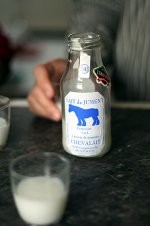♘امیرحسین♞
♘ مدیریت انجمن اسب ایران ♞
Horse milk trots onto the menu
Horse's milk could soon be available to pour over your cereal, according to a horse farm in Belgium that has started selling it across the world.
The farm milks 60 horses on a regular basis, and says its milk-mad customers can't get enough of it.
The healthy drink, which is low in fat and high in vitamins, is sold as a tasty alternative to cow's milk.
The milk, described as sweet, thin and watery, is also made into tablets, shampoo and creams to treat eczema.
The farmer decided to go in to horse milk production when new technology meant he didn't need his horses to work in the fields anymore.
Slow start
He's now been milking horses for more than eight years.
Although trade was slow to begin with, business is now booming and the farm is exporting the tasty treat to lots of different countries.
Horse's milk could soon be available to pour over your cereal, according to a horse farm in Belgium that has started selling it across the world.
The farm milks 60 horses on a regular basis, and says its milk-mad customers can't get enough of it.
The healthy drink, which is low in fat and high in vitamins, is sold as a tasty alternative to cow's milk.
The milk, described as sweet, thin and watery, is also made into tablets, shampoo and creams to treat eczema.
The farmer decided to go in to horse milk production when new technology meant he didn't need his horses to work in the fields anymore.
Slow start
He's now been milking horses for more than eight years.
Although trade was slow to begin with, business is now booming and the farm is exporting the tasty treat to lots of different countries.


